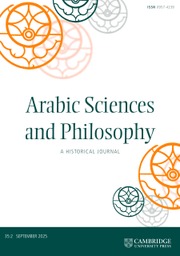Article contents
LA GÉOMÉTRIE DE L'ASTROLABE AU Xe SIÈCLE Geometry of the Astrolabe in the Tenth Century
Published online by Cambridge University Press: 15 May 2002
Abstract
Many studies on the astrolabe were written during the period from the ninth to the eleventh century, but very few of them related to projection, i.e., to the geometrical transformation underlying the design of the instrument. Among those that did, the treatise entitled The Art of the Astrolabe, written in the tenth century by Abū Sahl al-Qūhī, represents a particulary important phase in the history of geometry. This work recently appeared in a critical edition with translation and commentary by Roshdi Rashed. It contains the earliest known theory of the projection of the sphere, a theory developed in a commentary written by a contemporary mathematician, Ibn Sahl. Following R. Rashed, the present article offers here a thorough mathematical analysis of al-Qūhī's treatise and of the commentary by Ibn Sahl. It also presents, with commentary, an account of a contemporary treatise on the projection of the sphere, written by al-[Sdotu]āġānī. The latter work is concerned with the conical projection of a sphere on a plane, from a point on an axis of the sphere, other than its pole. The author consciously avoids the case of stereographic projection, but he studies all the other cases of conical projection which, if we employ the terms of al-Qūhī's theory, are compatible with the movement of the instrument (i.e. the rotation of the sphere around its axis). These three texts provide clear evidence of the emergence, during the second half of the tenth century, of a new field of study, that of projective geometry.
- Type
- Research Article
- Information
- Copyright
- © 2000 Cambridge University Press
- 3
- Cited by


